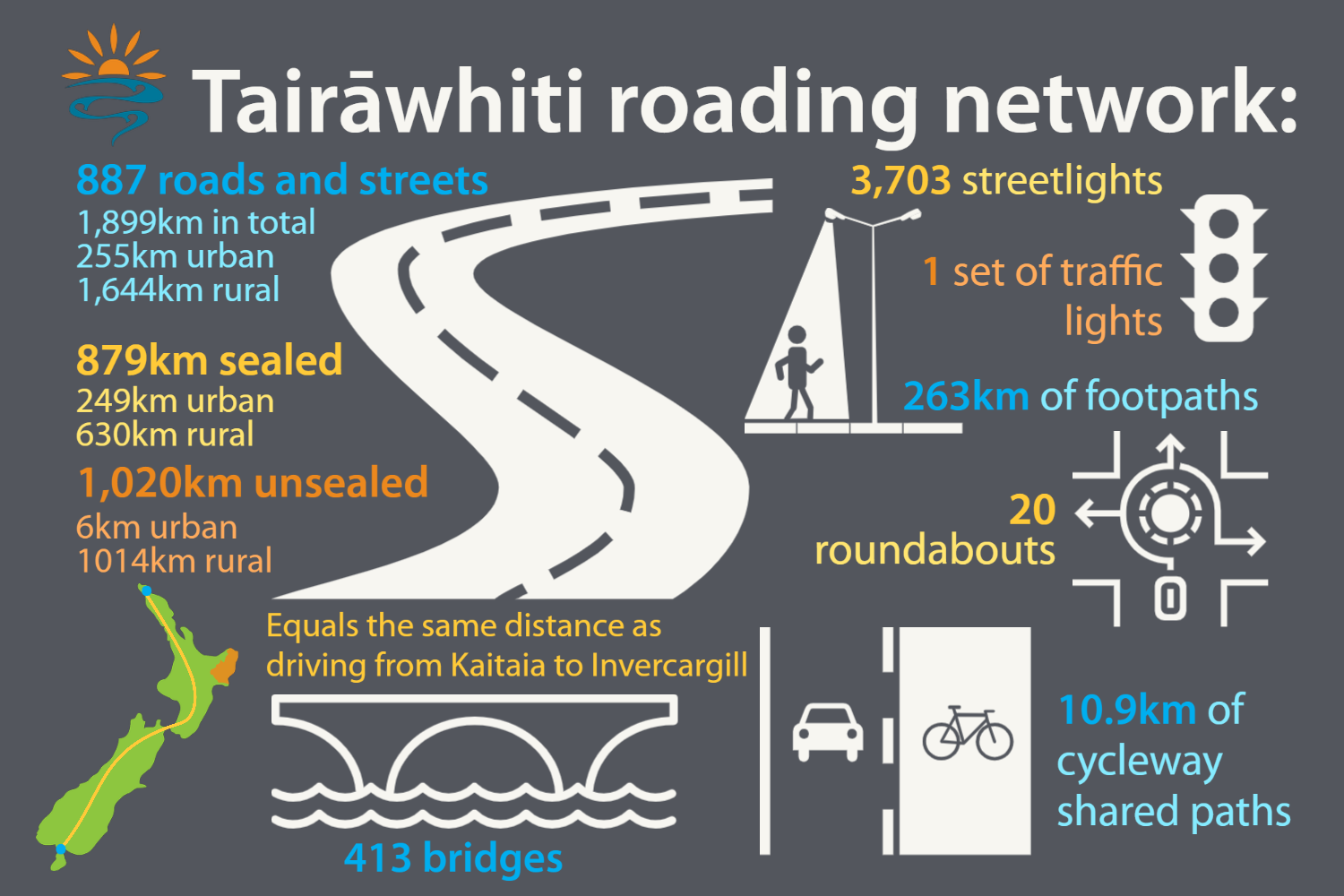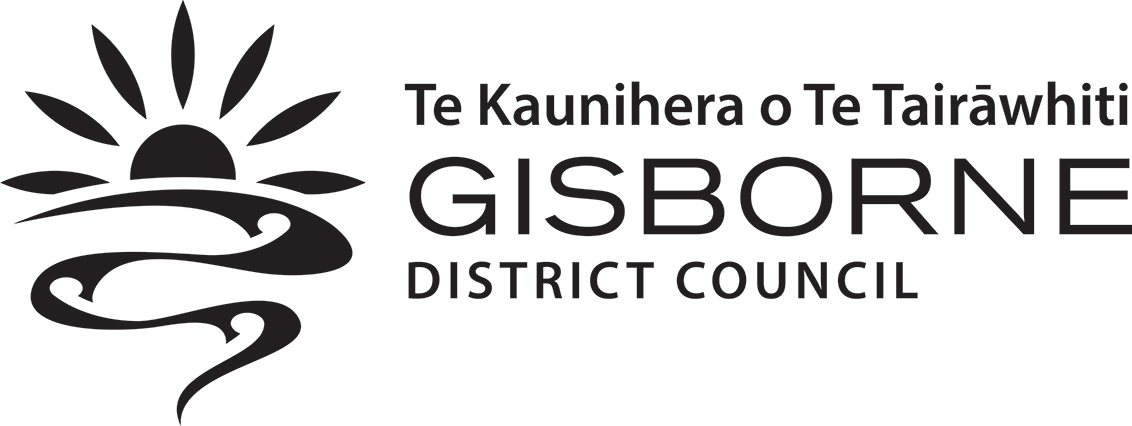Our local roading network includes 1899kms of local roads, 413 bridges and 263km of footpaths.
If you spot any issues on our local roads: Urgent - call our customer service team on 0800 653 800. Not urgent - use the eFix Request form or download the Antenno App to report it quickly and easily. eFix Request Form
Note: State highways in our district are managed by NZ Transport Agency.

The local road network forms 85% (1899km) of Tairāwhiti’s roads and equals the same distance as driving from Kaitaia to Invercargill.
- 87% of the roads are rural and 54% are unsealed - 1,899km in total - 255km urban and 1,644km rural,
879km sealed and 1,020km unsealed. - 413 bridges, culverts, and drains
- 263km of footpaths and footbridges,
- 3703 streetlights
- 20 roundabouts
- 10.9km of cycleway shared paths
- street signs, railings, retaining walls,
- one set of traffic lights,
- 2 public bus services, school bus service and bus shelters
Our fragile road network
Our district’s roading network goes over unstable and highly erodible land that's prone to slips and drop outs. Other ongoing issues include climate impact, more frequent flooding and increased heavy traffic volumes.
The cause of erosion in our district is a combination of soft rock geology, and in rural areas - historic vegetation clearance or deforestation. Over the last 12 years there’s been about a tenfold increase in freight to the port, which is an increase in heavy traffic volumes using the roads.
Our contractors

- Hikurangi - Blackbee Contractors Ltd
- Uawa - Downer NZ
- Waipaoa - Fulton Hogan Ltd
- Turanga - city area - Fulton Hogan Ltd
- Vegetation control for the entire network - Inline Group
- Annual reseals and maintenance for the entire network - Fulton Hogan Ltd
- Streetlights – ElectriNET
Our network consists of:
- 1899km of roads - 879km sealed and 1,020km unsealed. Total of 887 roads
- 263km of footpaths, 10.9km of shared paths
- 413 bridges and large culverts
- 3,703 streetlights
Potholes
Summer is the best time to fix potholes
The best time of year to permanently fix a pothole is generally October to March, if it's dry.
Winter, cooler or wet months are not the best time
Potholes cannot be repaired permanently when it's wet or too cold. We can only do a temporary repair using DGM or mix material. Depending on the size of the pothole and traffic numbers, this fix won't last and will keep failing until the permanent repair.
DGM is a bit like concrete - it needs time to set hard before you can drive on it. As we can’t close roads for long periods, as soon as the pothole's filled and traffic starts driving on it before it's had time to set, it sometimes fails.
Yes we do go back and continually refill the same potholes. This is frustrating but that's all we can do until the permanent fix.
To keep our roads safe if potholes are dangerous, we have to do a temporary fix to fill a pothole.
Fixing potholes
The permanent and best repair is 'mill and fill' done in summer. The pothole area is dug out up to 300mm deep and filled with new gravel, then patch sealed.
DGM is the material that potholes are filled with for a temporary fix. It sometimes won't last and may keep failing until a permanent repair.
We also waterproof the road to stop water getting under the surface in the first place. This is called crack sealing - it's those black lines on a sealed road.
How we prioritise potholes
Roads with more traffic generally take priority over very low volume roads.
Reporting potholes or other road defects
Report any issues with local roads to us.
For any issues on state highways contact Waka Kotahi NZTA
What's with all the potholes?
The how, why and when they're best fixed
Sealed roads
We have 879km of sealed roads in our district.
Each year we spend $13m on maintenance such as potholes and major surface fixes like chip seal and asphalt replacement.
Chip seal or asphalt road surface
To keep our roads safe and maintained, we sometimes need to rebuild support layers (pavement) and the surface (chip seal or asphalt).
New seals
Resurfacing involves spreading stone chip over a layer of hot sprayed bitumen. The new seal can take some time to settle down and extra care is required due to loose chip and sticky bitumen.
Our contractors take every precaution to avoid splashing bitumen, but if you get any small spots on your vehicle, it can be removed with kerosene or baby oil. If your vehicle gets splashed with cement, please wash it off as soon as possible.
Unsealed roads
We have 1,020km of unsealed rural roads in our district. About 150km of these carry heavy logging and stock vehicles.
Maintenance includes grading and gravel when needed.
Each year we spend about $8m on maintenance. This includes grading, new metal, maintaining drains and controlling vegetation, mowing and weed spraying.
Grading and gravel roads
When's the best time to grade a road?
Spring and autumn are the best times of year to grade roads for maximum benefit. Especially when the road is damp heavy maintenance grading will help restore the shape of the road and compact it to a dense surface.
Grading in winter is avoided where possible. This can make slushy conditions that take a long time to dry out making it unsafe for motorists.
Grading in mid-summer is also avoided. Cutting into a dry hard surface will leave a layer of loose material that reduces to dust. Then dust becomes an issue for traffic and nearby residents.
Corrugations will also reappear more easily on dry, loose surfaces which is why we avoid it, as it just makes more work.
How often are gravel roads inspected?
Our 4 maintenance contractors together with staff review the network every month. This frequency can change if we're impacted by a severe weather event.
We add about 25,000 cubic metres of new gravel to unsealed roads each year.
Roads with higher volumes of heavy traffic, such as logging and stock trucks increase the wear and tear of a road. High volume roads are re-graveled and graded more regularly.
The road surface should remain in good condition after grading, depending on the weather, geology, traffic volumes and driver behaviour.
Potholes on unsealed roads
Potholes are more common in wet weather - where the road is flat or there’s a hollow or corrugation. To reduce the number of potholes, roads are graded so the water flows to the side of the road.
Seasonal construction work
Work is scheduled at these times of year with flexibility to adjust to seasonal changes such as flooding and droughts.
| January - March | Completion of pre-reseals, reseals, pre-winter shutdown on construction |
|---|---|
| April - June | Heavy metaling until it's too wet, drainage, unsealed road grading as weather permits |
| July - September | Culverts, water tabling, minimal grading and aggregate |
| October - December | Pre-reseal repairs, heavy metaling, increased grading, reseals if possible |
Maintenance work schedule
Our maintenance work programme which includes grading, road sweeping, chip reseals.
You will be able to see when maintenance is due but this is also very weather dependent.
Streetlights
We maintain 3,703 streetlights in our region.
Eastland Network is the electricity lines company for Gisborne and the East Coast. They own the poles, wires and underground cabling used by electricity retailers to supply customers with electricity. Up to 30% of our streetlights are attached to an Eastland Network asset.
For health and safety reasons, Eastland Network only allow ElectriNET to work on their assets.
Report any streetlight issues on local roads.
Roading webpages
Road information
Local road and bridge closures and restrictions
Sealed and unsealed roads
Contractors, about potholes and maintenance
Planned road works
Schedule for maintenance and recovery work, search by road name
Bridge repair works
Programme of repairs or replacement
Bridge restrictions
Weight and speed limits
Overweight vehicle permit
Including high productivity motor vehicles and permits
Corridor Access Request
For work in the road reserve
Flood-damaged network
Following cyclones Gabrielle and Hale
Temporary traffic management
For events, list of providers
Temporary road closure
For an event
Request a speed hump
Criteria to apply for traffic calming measures
Street trees
Maintenance, Q&As about street trees
Public tree maintenance
Pruning and removal of public trees
Plans and documents
Speed limit and traffic and parking bylaws, engineering practices, transport plans
